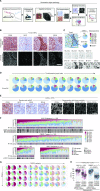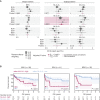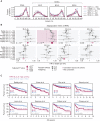Patterns of Oncogene Coexpression at Single-Cell Resolution Influence Survival in Lymphoma
- PMID: 37071673
- PMCID: PMC10157367
- DOI: 10.1158/2159-8290.CD-22-0998
Patterns of Oncogene Coexpression at Single-Cell Resolution Influence Survival in Lymphoma
Abstract
Cancers often overexpress multiple clinically relevant oncogenes, but it is not known if combinations of oncogenes in cellular subpopulations within a cancer influence clinical outcomes. Using quantitative multispectral imaging of the prognostically relevant oncogenes MYC, BCL2, and BCL6 in diffuse large B-cell lymphoma (DLBCL), we show that the percentage of cells with a unique combination MYC+BCL2+BCL6- (M+2+6-) consistently predicts survival across four independent cohorts (n = 449), an effect not observed with other combinations including M+2+6+. We show that the M+2+6- percentage can be mathematically derived from quantitative measurements of the individual oncogenes and correlates with survival in IHC (n = 316) and gene expression (n = 2,521) datasets. Comparative bulk/single-cell transcriptomic analyses of DLBCL samples and MYC/BCL2/BCL6-transformed primary B cells identify molecular features, including cyclin D2 and PI3K/AKT as candidate regulators of M+2+6- unfavorable biology. Similar analyses evaluating oncogenic combinations at single-cell resolution in other cancers may facilitate an understanding of cancer evolution and therapy resistance.
Significance: Using single-cell-resolved multiplexed imaging, we show that selected subpopulations of cells expressing specific combinations of oncogenes influence clinical outcomes in lymphoma. We describe a probabilistic metric for the estimation of cellular oncogenic coexpression from IHC or bulk transcriptomes, with possible implications for prognostication and therapeutic target discovery in cancer. This article is highlighted in the In This Issue feature, p. 1027.
©2023 The Authors; Published by the American Association for Cancer Research.
Figures






Comment in
- 2159-8274. doi: 10.1158/2159-8290.CD-13-5-ITI doi: 10.1158/2159-8290.CD-13-5-ITI
References
-
- Miao Y, Medeiros LJ, Li Y, Li J, Young KH. Genetic alterations and their clinical implications in DLBCL. Nat Rev Clin Oncol 2019;16:634–52. - PubMed
-
- Vaux DL, Cory S, Adams JM. Bcl-2 gene promotes haemopoietic cell survival and cooperates with c-myc to immortalize pre-B cells. Nature 1988;335:440–2. - PubMed

